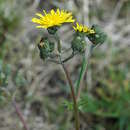Associations
provided by BioImages, the virtual fieldguide, UK
Foodplant / internal feeder
larva of Ensina sonchi feeds within capitulum of Crepis biennis
Foodplant / spot causer
amphigenous colony of Ramularia hyphomycetous anamorph of Mycosphaerella hieracii causes spots on live leaf of Crepis biennis
In Great Britain and/or Ireland:
Foodplant / parasite
Podosphaera fusca parasitises live Crepis biennis
Foodplant / parasite
uredium of Puccinia crepidicola parasitises live stem of Crepis biennis
Foodplant / spot causer
hypophyllous colony of Ramularia hyphomycetous anamorph of Ramularia crepidis causes spots on live leaf of Crepis biennis
Comments
provided by eFloras
Crepis biennis is recognized by its biennial habit, pinnately lobed leaves with triangular lobes, and relatively short hairs on the adaxial faces of the phyllaries. It has been reported from Newfoundland but apparently does not persist there.
- license
- cc-by-nc-sa-3.0
- copyright
- Missouri Botanical Garden, 4344 Shaw Boulevard, St. Louis, MO, 63110 USA
Description
provided by eFloras
Biennials, 20–120 cm (taproots branched). Stems 1, erect, slender to robust, branched proximally or near middles, ± setulose or glabrescent. Leaves basal and cauline; petiolate (at least basal); blades oblanceolate to runcinate, 5–25 × 1.5–7.5 cm, margins pinnately lobed or dentate (ter-minal lobes triangular), apices ± acute, faces slightly scabrous (hairs yellow, fine). Heads 12–14, in simple or compound, corymbiform arrays. Calyculi of 7–9, lance-linear, glabrous or tomentulose bractlets 3–6 mm. Involucres campanulate, 8–13 × 5–9 mm. Phyllaries 10–17 (pale to dark green or nearly black) linear-lanceolate, 10–11 mm, (margins scarious) apices acute to obtuse (ciliate), abaxial faces ± canescent-tomentose, adaxial often with yellowish or black, appressed hairs. Florets 30–100; corollas yellow, 12–18 mm. Cypselae yellowish or reddish brown, fusiform, 4–7 mm, apices narrowed (not beaked), ribs 13–20; pappi white, 5–7 mm (somewhat unequal). 2n = 40.
- license
- cc-by-nc-sa-3.0
- copyright
- Missouri Botanical Garden, 4344 Shaw Boulevard, St. Louis, MO, 63110 USA
Crepis biennis: Brief Summary
provided by wikipedia EN
Crepis biennis is a European species of flowering plant in the family Asteraceae with the common name rough hawksbeard. It is native to Europe and Asia Minor, as well as being sparingly naturalized in scattered locations in the northeastern United States and on the island of Newfoundland in eastern Canada. Many people think that they are dandelions because they look so alike but that is only because both are in the daisy family.
Crepis biennis is a perennial herb up to 120 cm (48 inches) tall. One plant can produce as many as 14 small flower heads, each with up to 100 yellow ray florets but no disc florets.
- license
- cc-by-sa-3.0
- copyright
- Wikipedia authors and editors

